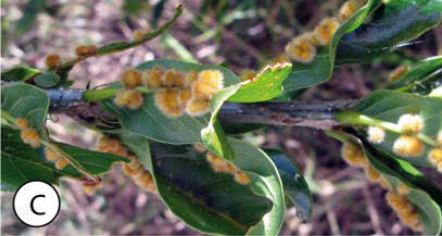Neuroterus pulchrigalla (agamic)
Neuroterus pulchrigalla Medianero & Nieves-Aldrey sp. n.(Figs. 3, 4 & 7A-B)
Gall (Figs. 8A-E). Galls have a cylindrical shape, measuring 5 x 2 mm. the gall surface is covered with long dense yellowish hairs. Internally, two parts are visible; an ovoid larval cell at the attachment of the gall on the leaf and an apical empty part (Fig. 8D). The galls grow isolated or more frequently grow in close clusters formed by 2-10 galls on the midrib of Quercus bumelioides leaves (Figs. 8A-C). The galls are yellow when fresh, orange when mature and brown when old. Galls are relatively abundant on Quercus bumelioides at the Volcán Barú site in Panama.
Distribution. Neuroterus pulchrigalla was found between 1,431-1,800 m above sea level at Volcán Barú and El Salto, Chiriquí Province, Panama. We have found galls of this species in the same type locality type as the other new species described in this paper from Panama.
Etymology. Named after the pretty, brilliantly colored leaf galls induced by this species.
Biology. Only the asexual generation of Neuroterus pulchrigalla is known, inducing galls on Q. bumelioides leaves. The galls are found between January and March, during the dry season, when new Q. bumelioides leaves begin to mature. The adult insects emerge from mature galls in February or May.
”- Medianero, E.; Nieves-Aldrey, J. L.: (2017) Primera Cita Del Género Neuroterus Hartig (Hymenoptera, Cynipidae, Cynipini) Para América Central, Con Descripción de Tres Especies Nuevas de Panamá Y Costa Rica©





